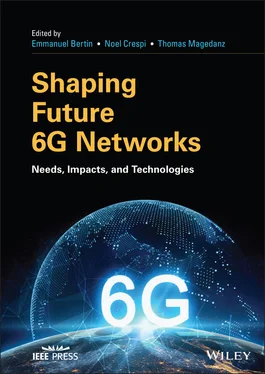Shaping Future 6G Networks
Здесь есть возможность читать онлайн «Shaping Future 6G Networks» — ознакомительный отрывок электронной книги совершенно бесплатно, а после прочтения отрывка купить полную версию. В некоторых случаях можно слушать аудио, скачать через торрент в формате fb2 и присутствует краткое содержание. Жанр: unrecognised, на английском языке. Описание произведения, (предисловие) а так же отзывы посетителей доступны на портале библиотеки ЛибКат.
- Название:Shaping Future 6G Networks
- Автор:
- Жанр:
- Год:неизвестен
- ISBN:нет данных
- Рейтинг книги:3 / 5. Голосов: 1
-
Избранное:Добавить в избранное
- Отзывы:
-
Ваша оценка:
- 60
- 1
- 2
- 3
- 4
- 5
Shaping Future 6G Networks: краткое содержание, описание и аннотация
Предлагаем к чтению аннотацию, описание, краткое содержание или предисловие (зависит от того, что написал сам автор книги «Shaping Future 6G Networks»). Если вы не нашли необходимую информацию о книге — напишите в комментариях, мы постараемся отыскать её.
Discover the societal and technology drivers contributing to build the next generation of wireless telecommunication networks Shaping Future 6G Networks: Needs, Impacts, and Technologies
Shaping Future 6G Networks
Shaping Future 6G Networks — читать онлайн ознакомительный отрывок
Ниже представлен текст книги, разбитый по страницам. Система сохранения места последней прочитанной страницы, позволяет с удобством читать онлайн бесплатно книгу «Shaping Future 6G Networks», без необходимости каждый раз заново искать на чём Вы остановились. Поставьте закладку, и сможете в любой момент перейти на страницу, на которой закончили чтение.
Интервал:
Закладка:
Each production facility and industrial area is a different use case with particular requirements. Industrial deployments, particularly in manufacturing, tend to have equipment and machinery with life cycles that extend over a decade. Therefore, the introduction and use of cellular networks for applications with stringent requirements is a long and gradual process that has started in dedicated deployments for a well‐defined set of application. Thus, the integration with existing equipment, wired solutions, and radio access technologies (RATs) will still be required for many years into the future to ensure backward compatibility and improve overall performance.
As front‐runners expand the applications relying on cellular networks, more complex deployments and applications will emerge. For example: dynamic deployments with URLLC requirements for exploration, mining activities, and wide area monitoring of pipelines, electric grids, and other critical infrastructures and the need for robots to perform cooperative maneuvers that require high precision and coordination. Moreover, for the factory cases with extreme performance requirements, it will be crucial to support URLLC in factory floors with moving objects and reshuffling manufacturing units. Digital twins (discussed in detail in Section 2.3.3) will also play an important role for industrial applications, where a digital twin replicates a real‐world object in a digitized environment, which would enable the evaluation of performance and outcomes of industrial applications in safe, digital environments before a solution is deployed in the real world.
In 6G we will see improved solutions to support multiple connectivity in the same deployment and application to improve reliability and performance through link diversity and aggregation. While some solutions are already available in 5G such as dual connectivity and carrier aggregation, 6G will cover the need to support and aggregate multiple RATs maintaining the latency and reliability requirements of industrial applications, which will also provide additional access to local spectrum. In addition, the integration of time‐sensitive networking (TSN) and deterministic networking (DetNet) standards that started in 5G will be fully utilized to support deterministic data transmission over cellular networks. Finally, network exposure and integration with cloud capabilities are key factors to enable the expansion of 6G for industrial applications, since they will enhance the network capability management and provide support for real‐time applications while keeping sensitive operational data on cloud deployments that are kept secured.
2.3.2 Teleportation
Teleportation represents the future of communication, enabling holographic delivery of life‐sized three‐dimensional (3D) stereoscopic experiences in real‐time without head‐mounted device (HMD) technologies like augmented reality/virtual reality (AR/VR).
As the business world becomes increasingly automated and ubiquitous, teleportation will stimulate remote telework by allowing flexible virtual interaction during business events and meetings involving geographically distributed colleagues and industries, thus eliminating time and distance barriers. This technology may also decrease carbon footprint (the combustion of fuel for transport accounts for about 30% of global greenhouse gas emissions 2 ) and save travel time and expenses, revitalizing small and medium‐sized enterprises with limited corporate travel capabilities. Furthermore, replacing in‐person business meetings with holographic events may improve labor productivity through more concise interaction and reduced stress for travel planning. Compared to video conferencing technologies, teleportation supports body language and nonverbal communication, thus guaranteeing better audience engagement and reception of information as well as enhanced productivity during professional events. Finally, even though business travel will always represent an essential resource for many company divisions, from sales to marketing, and from production to research and development, it is expected that teleportation will represent a valuable alternative for future corporate business.
Teleportation does not refer only to the digital transmission of physical quantities; it will also enable a clear and reproducible digital representation of all human senses, including smell and taste. This will allow, for example, chemical industries to speed up pharmaceutical product preparation and development via virtualization of drug tests,; healthcare companies to implement noninvasive, real‐time diagnostic tools for health monitoring; and agro‐food industries to tailor their offerings to consumer preferences while improving quality control of raw materials and increasing the overall efficiency of the food system.
Despite these benefits, remote connections via teleportation will introduce significant demands on the 6G network infrastructure, which are not supported today [2]. Specifically, 5G and previous generations have been typically designed to support audio and 2D‐like video communication, where the same data content is broadcast regardless of the viewer’s position. In turn, 3D telepresence adds parallax, meaning that the image changes depending on the viewer’s position and its interaction with the image itself. This approach will radically change the role of the user (from passive video consumer to interactive consumer of multi‐sensory experiences) and lead to a massive increase in the requirements for capturing, transmitting, and interacting with teleportation services. To fully realize an immersive remote experience, all human senses, including touch, smell, and taste, together with video and audio information, will be digitized and transferred across future networks at a data rate up to several terabits per second, which depends on the sensor’s resolution and frame rate: for example, a raw uncompressed hologram with colors, full parallax, and 30 fps would require 4.32 Tbps [1]. The latency requirement will also be very challenging to ensure interactive content provisioning and real‐time communications. While the 5G paradigm sets the round‐trip latency limit in the RAN to 1 ms, 6G technologies will hit the sub‐milliseconds to make the holographic experience smoother and more immersive. Finally, hologram‐based applications will need to process a massive number of streams originating from sensors at different angles of view, thus involving stringent synchronization requirements.
2.3.3 Digital Twin
A digital twin is a digital replica of an object, generally characterized by a very high level of fidelity that makes it possible to use the digital version as a reliable representation of the behavior and characteristics of the real object [3]. The concept of digital twins has risen to the forefront of the discussion on product life cycle management thanks to improvements in the design and capabilities of sensors (e.g. video cameras, laser scanners, and lidars) and sensor fusion algorithms, which now allow a rich and faithful representation of the real object, as well as thanks to advances in computation capabilities, which enable the real‐time manipulation and editing of the digital twin. Moreover, the concept of digital twin is often associated to VR and AR, as the digital representation can be visualized through any immersive visualization technique. Thanks to these properties, digital twins can improve the design, engineering, inspection, and maintenance of complex machines and devices. For example, a machine could be remotely inspected without the need for personnel on the ground, without any loss of realism, and with an improved (digital) access to components that would be hard to reach physically. Similarly, mechanics can monitor the performance and status of different components of a vehicle with a high‐fidelity representation without the need for the car to be in the repair center. Additionally, for product development, a digital twin would allow different teams to work on the same product, exploiting a 3D, shared visualization in various remote locations, and can enable advanced simulations of the product behavior.
Читать дальшеИнтервал:
Закладка:
Похожие книги на «Shaping Future 6G Networks»
Представляем Вашему вниманию похожие книги на «Shaping Future 6G Networks» списком для выбора. Мы отобрали схожую по названию и смыслу литературу в надежде предоставить читателям больше вариантов отыскать новые, интересные, ещё непрочитанные произведения.
Обсуждение, отзывы о книге «Shaping Future 6G Networks» и просто собственные мнения читателей. Оставьте ваши комментарии, напишите, что Вы думаете о произведении, его смысле или главных героях. Укажите что конкретно понравилось, а что нет, и почему Вы так считаете.












